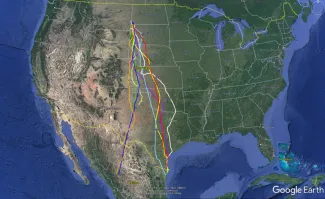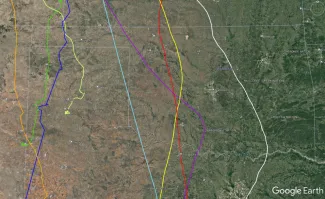North America’s largest shorebird, the long-billed curlew, has captured the attention of a research team working in the prairies of North and South Dakota. Their multi-year study focuses on the movements and habitat preferences of curlews as the birds nest in the Northern Plains states but also tracks curlew migration through other states, including Oklahoma. This year the movements of nine birds have been tracked, eight of which flew through Oklahoma as they migrated south in June and July.
“We want to know more about how they’re using the North Dakota landscape – how they’re using grasslands and cropland and wetlands,” said Sandy Johnson, conservation biologist for the North Dakota Game and Fish Department. “But we also want to know how long it takes them and what path they’re taking to migrate south.”
By mid-July, all of the tagged curlews had started their southbound migration and were sending data back to Johnson and the research team. Eight of the nine tagged birds made use of Oklahoma airspace; seven flew directly over Oklahoma without stopping, and one landed in Texas County for about 20 hours before continuing south. The eight birds passed through Oklahoma in a 24-day window.

The migration of nine long-billed curlews were tracked from North and South Dakota to Texas and Mexico.

Eight of the nine tracked curlews made use of Oklahoma airspace; seven flew directly over Oklahoma without stopping, and one landed in Texas County for about 20 hours before continuing south.
- Red: This female curlew, tagged in North Dakota with leg band “6H,” began its migration on June 14 and flew almost 1,500 miles nonstop. It flew through the body of Oklahoma on June 17 and continued on to the Texas coast, where it landed on June 19. This bird was last reported in the Laguna Atascosa National Wildlife Refuge.
- White: On June 21, a female tagged in South Dakota flew over Oklahoma.
- Dark Blue: On June 24, a male tagged in North Dakota flew over Oklahoma.
- Dark Green: On July 3, a male tagged in North Dakota flew over Oklahoma.
- Light Green: On July 5, a female tagged in South Dakota landed in northwestern Texas County for about 20 hours before continuing south on July 6.
- Orange: On July 6, a female tagged in North Dakota flew just west of the Oklahoma Panhandle.
- Light Blue: On July 8, a male tagged in North Dakota flew over Oklahoma.
- Purple: On July 8, a female tagged in South Dakota flew over Oklahoma.
- Yellow: On July 11, a female tagged in South Dakota flew over Oklahoma.
While the curlew’s long bill and taxonomic classification as a shorebird indicate a wetland lifestyle with muddy foraging bouts for worms, shrimp, and crabs, this typecasting holds only for the bird’s extended nonbreeding season. Curlews shift to a grassland lifestyle – with a grasshopper- and bird egg-heavy diet – during their brief stint on Northern and Western Great Plains breeding grounds. Nesting has occurred in Oklahoma’s Panhandle, but most Oklahoma sightings are associated with migrating individuals.
“Long-billed curlews have such a brief stopover in Oklahoma that it would be hard to design a similar study in our state,” said Mark Howery, senior wildlife biologist for the Oklahoma Department of Wildlife Conservation. “We’re grateful to learn more about the migratory route of this species of greatest conservation need through our state as a byproduct of North Dakota’s State Wildlife Grant and other nongame funds.”
Biologists expect the transmitters to send data on the bird’s locations for up to a year and a half. Curlew updates are planned on the North Dakota Game and Fish Department’s social media channels. Additional study details can be found in "North Dakota Outdoors."
This study is funded by North Dakota’s State Wildlife Grant Program and Nongame Fund.
